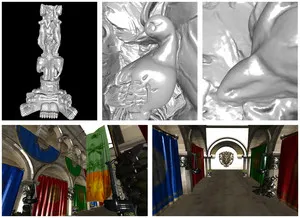Vector-to-Closest-Point Octree for Surface Ray-Casting
Ismail Demir, Rüdiger Westermann
Computer Graphics and Visualization Group, Technische Universität München, Germany

Background
GPU voxel-based surface ray-casting has positioned as an interesting alternative to rasterization-based rendering approaches, because it allows using many processing units simultaneously, can effectively exploit thread level parallelism, and enables fine-granularity occlusion culling on the pixel level. Yet voxel-based techniques face the problem that an extremely high resolution is necessary to avoid block artifacts at high zoom levels. In this work, we propose a novel improvement of voxel-based ray-casting to overcome this limitation. By using a hierarchical Vector-to-Closest-Point (VCP) representation, we can inherit the advantages of a voxel-based approach at a much smoother approximation of the surface. We demonstrate that, although the VCP grid consumes more memory per cell, it requires less memory overall, because it builds upon a significantly shallower tree hierarchy. In a number of examples we demonstrate the use of our approach for high-quality rendering of high resolution surface models.
Acknowledgment
This work was supported by the European Union under the ERC Advanced Grant 291372 - SaferVis - Uncertainty Visualization for Reliable Data Discovery.